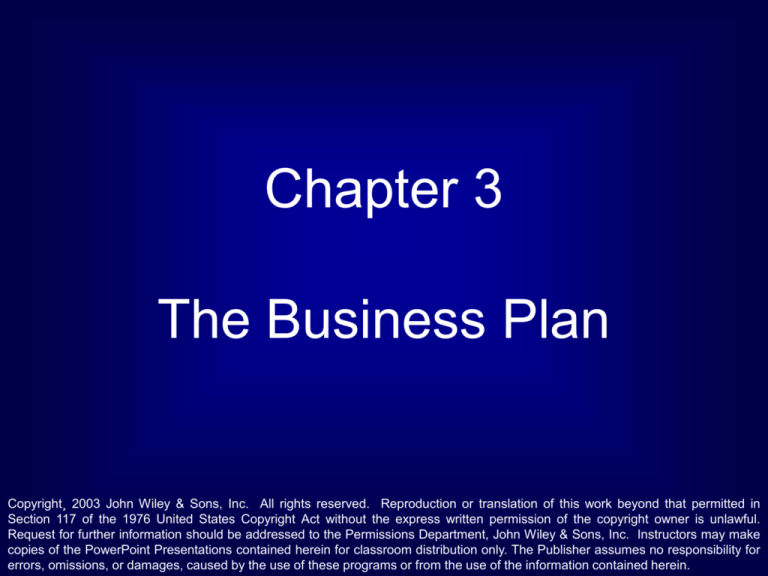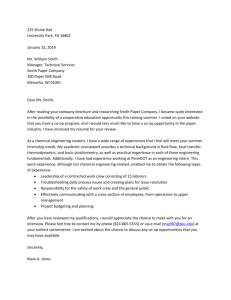
Chapter 3
The Business Plan
Copyright¸ 2003 John Wiley & Sons, Inc. All rights reserved. Reproduction or translation of this work beyond that permitted in
Section 117 of the 1976 United States Copyright Act without the express written permission of the copyright owner is unlawful.
Request for further information should be addressed to the Permissions Department, John Wiley & Sons, Inc. Instructors may make
copies of the PowerPoint Presentations contained herein for classroom distribution only. The Publisher assumes no responsibility for
errors, omissions, or damages, caused by the use of these programs or from the use of the information contained herein.
Learning Objectives
• How and why business plans of new ventures are
different
• What to include and what to leave out
• Relationship to strategic planning
• Using milestones and financial projections
• Signaling the entrepreneur’s beliefs, commitment,
and capabilities
• Facilitating negotiation with outside investors
• Tailoring plans to the needs of specific investors
• Due diligence
©2003, Entrepreneurial Finance, Smith and Kiholm Smith
Chapter 3
What Is a Business Plan?
• A written document
• Summarizes purpose and overriding strategy of the
venture
• Details on operation, financing, marketing, and
management
A set of hypotheses about an opportunity
©2003, Entrepreneurial Finance, Smith and Kiholm Smith
Chapter 3
Your business plan should
answer three questions
• 1. Is there really an opportunity to serve
an important customer need or want?
• 2. Do the numbers work out favorably?
• 3. Does the opportunity really match
your personal goals and values, and will
you have the abilities and resources
required to exploit the opportunity?
©2003, Entrepreneurial Finance, Smith and Kiholm Smith
Chapter 3
What Makes the Business Plans
of New Ventures Different?
• Forecasts and projections are usually less precise.
• A greater investment in planning may be warranted.
• Deviations from plans are likely to be due to wrong
assumptions.
• Not very useful for evaluation of manager
performance.
• More likely to be relied on externally.
• More likely to be used to attract investment capital.
• Often require greater breadth of coverage.
• Unconstrained by previous decisions.
©2003, Entrepreneurial Finance, Smith and Kiholm Smith
Chapter 3
Do the Planning
Before the Writing
• Preparing a business plan is not the first step.
• The plan can commit the entrepreneur to an
undesirable strategy.
• Consider aspects of strategy simultaneously, not
sequentially.
• Do not lose sight of the objective.
• Analysis of strategic alternatives does not belong in
the business plan.
• Be prepared to respond to alternative proposals.
©2003, Entrepreneurial Finance, Smith and Kiholm Smith
Chapter 3
What capital providers like:
• 1. A clear definition of the business (mission)
– What problem/need does it meet?
• 2. Evidence of marketing capability
– How will the business add significant value for the
benefit of the consumer?
• 3. Evidence of management capability.
– Is the opportunity a good fit with the founders?
• 4. An attractive financial arrangement.
– Is there a robust market / margin / money-making
potential?
©2003, Entrepreneurial Finance, Smith and Kiholm Smith
Chapter 3
What they don’t like:
• Obsession with product
• Unrealistic financial projections
• Inability to come to terms with the
details
• Failure to deal with potential critical
risks
• A “prepackaged” plan or fill in the blanks
©2003, Entrepreneurial Finance, Smith and Kiholm Smith
Chapter 3
Alternative Product Market and
Financing Choices
Figure 3-1
Alternative Product Market and Financing Choices:
Net Present Value to the Entrepreneur
Financing Choice
Product Market Choice
Small Scale - Slow Growth
Small Scale - Rapid Growth
Large Scale - Slow Growth
Large Scale - Rapid Growth
Entrepreneur Entrepreneur Entrepreneur +
Entrepreneur
+ Debt
+ Equity
Debt + Equity
$100
$60
$60
$20
©2003, Entrepreneurial Finance, Smith and Kiholm Smith
$40
$80
$50
$40
$30
$20
$120
$80
$10
$90
$70
$100
Chapter 3
Contents of the Business Plan
• Focus on the purpose(s) and uses of the plan.
• Make certain the audience is neither overloaded nor
left to speculate.
• Identify the key assumptions as assumptions.
– Include the support for key assumptions.
• Highlight the critical elements for success or failure.
• Delineate milestones so users can evaluate success,
modify assumptions, expectations, or strategy.
• Include financial projections to test the plan, commit
the entrepreneur, facilitate negotiation.
©2003, Entrepreneurial Finance, Smith and Kiholm Smith
Chapter 3
Outline of a Typical
Business Plan
Executive Summary
I. Background and Purpose of Venture
II. Market Analysis
III. Products and Services
IV. Development, Production, and Operations
V. Organization and Management
VI. Ownership and Control
VII. Financial Information
©2003, Entrepreneurial Finance, Smith and Kiholm Smith
Chapter 3
Business Plan Outline
•
•
•
•
•
•
•
•
•
•
Cover Page
Executive Summary
Mission Statement
Business Description
Management
Market Served
Competition
Product or Service
Selling
Organization
©2003, Entrepreneurial Finance, Smith and Kiholm Smith
• Personnel
• Financial Data
– Start-up costs
– Cash Flow Analysis
• Financing Plan
• Investment Returns
• Design and
Development
• Manufacturing and
Operations
• Appendices
Chapter 3
Making the Business Plan
Credible
• Demonstrate understanding of the technology,
market, risks, needs, and potential rewards.
• Provide evidence of the quality and capabilities of
people involved, and that they can function effectively
as a team.
• Provide evidence that key personnel are committed:
– Bonding
– Reputation
– Certification
©2003, Entrepreneurial Finance, Smith and Kiholm Smith
Chapter 3
“C’s” The Day
• Character. What do you bring personally to the
business.
– Commitment
– Creativity
• What is special about your product/service
– Credit
– Competency
– Courtesy
©2003, Entrepreneurial Finance, Smith and Kiholm Smith
Chapter 3
“C’s” The Day
• Cash. Generally, the bank is going to require
borrower to have equity investment of one-third.
– Cash for Start-up
– Cash-In
• Accuracy of Revenue Streams
– Cash-Out
• Costs
©2003, Entrepreneurial Finance, Smith and Kiholm Smith
Chapter 3
“C’s” The Day
• Collateral. What the bank will request a right to in
event of loan default.
– Capital Investment
• Property
• Equipment
• Inventory
• Land
• Vehicles
– Contracts
©2003, Entrepreneurial Finance, Smith and Kiholm Smith
Chapter 3
“C’s” The Day
Conditions. How will the following
affect the proposed business?
– Competition
– Customers
– Critical Workers
– Contracts
©2003, Entrepreneurial Finance, Smith and Kiholm Smith
– Conditional
Planning
– Controls
– Capacity
Chapter 3
The Issue of Confidentiality
•
•
•
•
Protecting intellectual property
Preemption and first-mover advantage
Using non-disclosure agreements
Relying on reputation
©2003, Entrepreneurial Finance, Smith and Kiholm Smith
Chapter 3
Financial Aspects of the
Business Plan
• Differing views on what to include
• Is the future too uncertain to warrant careful
forecasting?
• In the plan, or as an appendix
• The importance of supporting assumptions
• Relationship of projections to contract negotiation
• The value of quantifying risk
• Value as a diagnostic tool - to facilitate adaptation
• Updating the business plan
©2003, Entrepreneurial Finance, Smith and Kiholm Smith
Chapter 3








